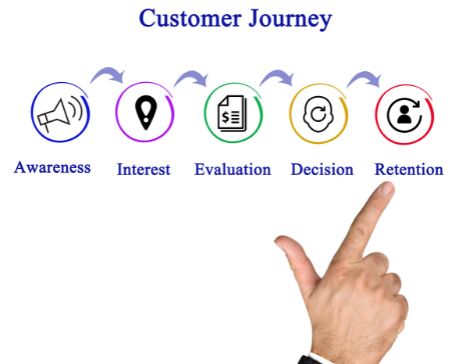
How to Track the Customer Journey with Cross-Channel Attribution
In today’s digital world, customers interact with brands through multiple channels before deciding to make a purchase. Cross-channel attribution has become an essential tool for marketers who want to understand these complex customer journeys.
Think of cross-channel attribution as a GPS for your marketing efforts. It shows you how customers move between different channels – such as social media, email, paid ads, and in-store visits – and tracks their path to conversion. This knowledge helps you:
- Identify which channels are most effective
- Allocate marketing budgets wisely
- Create seamless customer experiences across platforms
- Measure the true return on investment (ROI) of marketing campaigns
The modern customer journey isn’t straightforward. A potential buyer might discover your brand on Instagram, research your products on Google, sign up for your email newsletter, and finally make a purchase after seeing a retargeted Facebook ad. Without cross-channel attribution, you’d miss these crucial connections.
Data shows that customers typically use an average of six touchpoints when making a purchase decision. This reality of multiple channels makes it crucial to track and understand customer behavior for marketing success.
In this guide, you’ll learn how to implement effective cross-channel attribution strategies, overcome common challenges, and use advanced tracking methods to improve your marketing performance across all channels. For example, using native advertising can be a powerful strategy in this context. By analyzing successful native ads, you can create winning campaigns that generate more from your advertising budget.

The Evolution from Traditional to Cross-Channel Marketing
Traditional marketing operated in silos – separate teams managing individual channels like TV, print, radio, and direct mail. This fragmented approach created significant blind spots in understanding customer behavior and measuring campaign effectiveness.
Consider these limitations of traditional marketing:
- Disconnected Data: Each channel generated isolated metrics
- Limited Customer Insights: No visibility into cross-channel customer interactions
- Inefficient Budget Allocation: Decisions based on incomplete performance data
- Inconsistent Messaging: Different teams creating unaligned campaign content
Cross-channel marketing transforms this disconnected landscape into an integrated ecosystem. You track customers as they move between social media, email, website visits, and offline touchpoints. This connected approach reveals valuable patterns in customer behavior.
Modern cross-channel strategies deliver:
- Unified Customer Profiles: Combining data from multiple touchpoints
- Sequential Messaging: Coordinated campaigns that build on previous interactions
- Dynamic Budget Optimization: Real-time adjustment based on channel performance
- Consistent Brand Experience: Aligned messaging across all customer touchpoints
The shift from traditional to cross-channel marketing reflects changing consumer behavior. Your customers don’t interact with brands through a single channel – they research products on mobile devices, read reviews on social media, and make purchases through various platforms. Cross-channel attribution captures these complex customer journeys and helps you optimize marketing efforts across all channels.
Benefits and Challenges of Cross-Channel Attribution
Cross-channel attribution presents both significant advantages and complex challenges for marketers striving to understand their customers’ journey.
Key Benefits
1. ROI Optimization
- Precise tracking of conversion value across multiple channels
- Identification of high-performing touchpoints
- Clear insights into customer acquisition costs
- Data-driven decisions for campaign optimization
2. Strategic Budget Allocation
- Real-time adjustment of marketing spend
- Resource distribution based on channel performance
- Elimination of underperforming channels
- Investment scaling in successful touchpoints
3. Enhanced Customer Understanding
- Detailed mapping of customer interactions
- Recognition of influential touchpoints
- Insight into preferred communication channels
- Personalization opportunities through behavior analysis
Critical Challenges
1. Credit Attribution Complexity
The task of splitting conversion credit between channels poses significant technical hurdles:
- Social media impression vs. email click
- Display ad view vs. direct website visit
- Organic search vs. paid advertising impact
- Brand awareness channels vs. direct response media
2. Conversion Point Determination
Customer journeys rarely follow a linear path:
- Multiple devices used in single purchase
- Varying time spans between touchpoints
- Cross-device tracking limitations
- Different attribution windows per channel
3. Data Integration Obstacles
Combining data from diverse sources creates technical challenges:
- Incompatible data formats
- Inconsistent tracking parameters
- Platform-specific metrics
- Privacy compliance requirements
4. Multi-Touch Attribution Models
Selecting the right attribution model impacts accuracy:
- First-touch attribution may undervalue nurturing channels
- Last-touch attribution ignores awareness channels
- Linear models might oversimplify complex journeys
- Custom models require extensive testing and validation
The implementation of cross-channel attribution demands sophisticated tools and expertise. Marketing teams must balance the desire for detailed insights with practical limitations of data collection and analysis. Success requires continuous refinement of attribution models and regular assessment of tracking methodologies.
Advanced Approaches in Multi-Channel Attribution
Modern marketing demands sophisticated approaches to track and analyze customer interactions across multiple channels. Let’s explore three powerful strategies that revolutionize cross-channel attribution.
Omni-Channel Marketing Integration
Omni-channel marketing creates a unified brand experience across all customer touchpoints. Unlike traditional multi-channel approaches, omni-channel marketing:
- Synchronizes messaging across physical stores, mobile apps, social media, and websites
- Adapts content based on previous customer interactions
- Maintains context as customers switch between channels
- Personalizes experiences using real-time data
Unified Marketing Measurement (UMM)
UMM combines different measurement approaches to create a comprehensive view of marketing performance. This advanced methodology:
- Integrates top-down and bottom-up measurement
- Analyzes both online and offline channels
- Provides real-time performance metrics
- Enables cross-channel optimization
AI-Driven Analytics Tools
Artificial intelligence transforms cross-channel attribution through:
- Predictive Analytics
- Forecasts customer behavior patterns
- Identifies high-value conversion paths
- Suggests optimal channel combinations
- Machine Learning Models
- Processes complex data relationships
- Adapts to changing customer behaviors
- Discovers hidden patterns in attribution data
- Automated Attribution
- Assigns credit to channels in real-time
- Updates attribution models automatically
- Reduces manual analysis time
These advanced tools enable marketers to:
- Track customer interactions across devices
- Measure the impact of brand exposure
- Identify cross-channel synergies
- Create dynamic attribution models
The combination of omni-channel marketing, UMM, and AI-driven analytics creates a powerful framework for understanding and optimizing the customer journey. These approaches provide marketers with actionable insights to make data-driven decisions and improve campaign performance across all channels.
Implementing Effective Cross-Channel Attribution Strategies
Real-time data access is crucial for successful cross-channel attribution. You need up-to-date and accurate data to make informed decisions about your marketing campaigns. Automated data collection systems can help you achieve this by ensuring data accuracy and reducing manual errors.
Key Data Requirements for Attribution Success:
- Customer interaction timestamps
- Channel-specific engagement metrics
- Conversion event details
- Campaign cost data
- Customer segment information
Handling Conversion Latency
Handling conversion latency presents unique challenges in cross-channel attribution. Time decay models offer a practical solution by assigning different weights to touchpoints based on their proximity to the conversion event. Here’s an example of how a typical time decay model might attribute credit:
- 40% credit to touchpoints within 24 hours of conversion
- 30% credit to touchpoints 2-7 days before conversion
- 20% credit to touchpoints 8-14 days before conversion
- 10% credit to touchpoints beyond 14 days
Predictive analytics methods enhance latency handling by forecasting likely conversion patterns. Machine learning algorithms analyze historical data to identify patterns and predict future customer behaviors, allowing you to adjust attribution models proactively.
Essential Analytics Tools Features:
- Cross-platform data integration capabilities
- Custom attribution model creation
- Real-time reporting dashboards
- Predictive analytics functionality
- Automated data validation
Popular analytics platforms like Google Analytics 4, Adobe Analytics, and Mixpanel provide robust attribution features. These tools offer pre-built attribution models while allowing customization based on your specific business needs.
Advanced Attribution Techniques:
- Path analysis for identifying common conversion routes
- Multi-touch attribution modeling
- Cross-device tracking
- Customer segment-specific attribution rules
- Revenue impact analysis
Custom attribution rules help account for industry-specific factors. You might assign higher weights to certain channels during seasonal peaks or adjust attribution windows based on your product’s typical sales cycle.
Conclusion
Cross-channel attribution is a game-changing approach in modern marketing strategy. It allows businesses to track and understand customer interactions across multiple channels, enabling them to make data-driven decisions that directly impact their bottom line.
The true power of cross-channel attribution lies in its ability to:
- Reveal hidden patterns in customer behavior
- Identify the most effective channel combinations
- Optimize marketing spend based on real performance data
- Create seamless customer experiences across all touchpoints
Your success with cross-channel attribution depends on maintaining clean, up-to-date data and selecting the right attribution tools for your specific needs. The investment in proper attribution modeling pays off through enhanced marketing efficiency and improved ROI.
Key Success Factors:
- Regular data analysis and updates
- Integration of both online and offline channels
- Implementation of advanced attribution models
- Continuous optimization based on insights
The future of marketing belongs to businesses that can effectively track, measure, and optimize their cross-channel performance. By implementing robust attribution strategies, you position your organization to deliver personalized experiences that resonate with customers while maximizing the impact of every marketing dollar spent.
Remember: Cross-channel attribution isn’t just about tracking conversions—it’s about understanding your customers’ journey and using that knowledge to create meaningful connections that drive sustainable business growth.


